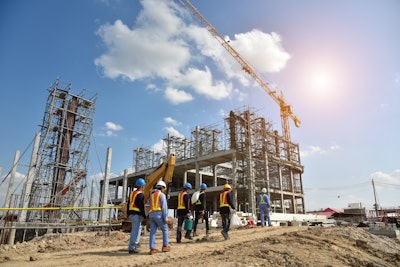
Similar to many other industries, success in construction is rooted in effective, transparent collaboration. For general contractors, maintaining strong relationships with owners, subcontractors and other stakeholders is critical to keeping projects on time and on budget—particularly in tight and volatile economic times like these.
Slow money movement threatens the stability and progress of any given project. It is crucial that all stakeholders are able to effectively collaborate in order to keep things moving along smoothly, even if their financial interests differ. For general contractors, those interests include protecting the project from mechanic’s liens, receiving timely payment from the owner, and making secure payments to subcontractors.
Unfortunately, according to PwC, the construction industry has a days sales outstanding average of 51 days—the longest of any industry in the country—which is largely the result of relying upon inefficient processes to handle complex requirements. When subcontractors don't receive on-time payment, they may not have the funds to purchase materials or pay their own vendors, resulting in project delays and missed deadlines. Many general contractors still follow a "pay-when-paid" model, which necessitates that they receive payment from the owner before issuing payments to their subcontractors.
While delays are costly and often cause friction between stakeholders, there are solutions that eliminate many of these barriers to expediency so that compliance, billing, and building can all go hand-in-hand.
Speeding Up The Payment Process
Sending the right paperwork speeds up the payment process. Most general contractors require their subcontractors to request payment via a pay application, which is a detailed construction invoice with a number of supporting documents. This group of documents provide information about the progress of their contract and requests payment for the work completed. In the past, these documents were scanned one at a time and sent to the general contractor via email or snail mail—a very time consuming and error prone process. With the right technology, pay application and relevant supporting documentation can be uploaded in bulk with a click of a button, which saves both parties hours of work.
The next step is for the general contractor to package up all the payment applications from their various subcontractors and submit them to the owner of the project for payment. In addition to the pay application, the general contractor often needs to collect applicable conditional lien waivers from the project’s subcontractors.
Tracking subcontractor compliance starts with collecting all required certificates of insurance from project participants. As the project progresses, ensuring compliance is maintained becomes quite challenging given that each sub carries multiple certifications each with varying renewal timelines. Centralizing and digitizing the management and submission of compliance documents makes it easier for the general contractor to track and keep audit trails of payment documents. Simplifying the payment paperwork process is step one in providing transparency, visibility, and partnership between stakeholders. Step two is delivering the payment itself. Plus, with added visibility and transparency via technology, owners can proceed with confidence.
Current Economic Factors Require Change
In addition to overcoming archaic processes, the difficult macroeconomic environment is placing strain on the construction sector. General contractors are facing pressures tied to high inflation, a severe labor shortage, and supply chain issues stemming from 2020. This has led to quality subcontractors being tougher to come by and pricier to secure. As a result, builders are paying inflated hiring costs while tradespeople just want (and need) to get paid on time. To best serve all construction stakeholders’ interests, contractors can leverage automation and turn to digitizing records for critical processes: pre qualifying subcontractors, collecting pay applications, managing lien waivers and compliance documentation, monitoring lower-tier vendors, and confidently making payments without worry. These are all important because project success is highly dependent on making sure everyone’s documentation is submitted on time for each draw. Otherwise, it creates a tremendous amount of risk.
The time is now to centralize engagement, digitize workflows, mitigate risk and improve project and financial outcomes for everyone involved so that construction spending, especially in the commercial sector, can continue to play its vital role in spurring job growth and acting as a bellwether for GDP. With the right software, contractors can ensure better efficiency, accuracy and accountability—avoiding payment and compliance challenges, and finishing a project on time. Technology ultimately leads to faster payments for all.
Better Collaboration Minimizes Risk
It’s essential to combat inefficiencies and friction points with clear communication between all stakeholders on a given project. Email and asynchronous correspondence won’t cut it; contractors need a more robust audit trail and reminders for next steps. Furthermore, construction stakeholders need transparency to critical information from other stakeholders involved in the project. Everyone should know what paperwork is required. When anyone in the chain is out of compliance, it can be addressed quickly before it slows things down. Contractors need money to move quickly to keep subcontractors engaged in projects, especially in a competitive market. As contractors evaluate the old ways of working with subcontractors and other stakeholders, it’s easy to see that there are tremendous inefficiencies in managing processes using manual methods. An obvious benefit of technology investment is that it helps to build and strengthen relationships with the rest of the ecosystem.
The construction industry is one big ecosystem where every stakeholder is reliant on others—to efficiently pay or get paid, and to receive and verify project-critical documentation. While the economy may be uncertain, communication and projects shouldn’t be. Our shared goal should be to allow everyone building the world around us to collaborate more seamlessly.

















